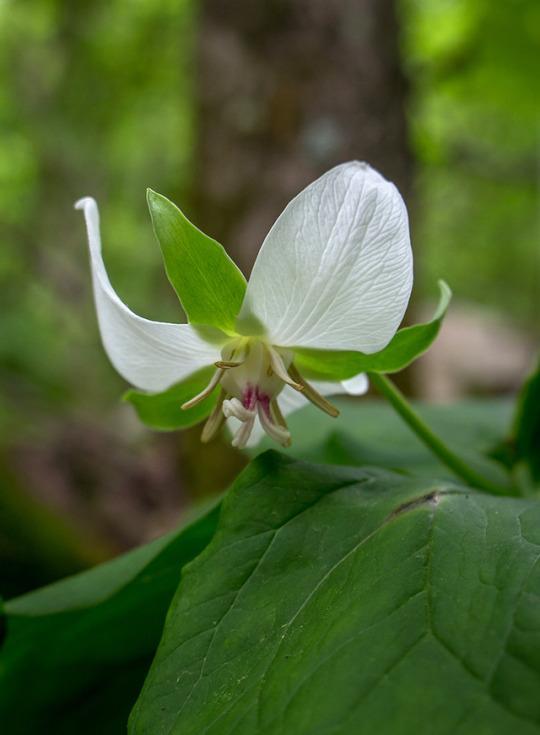#Trillium flexipes
Text
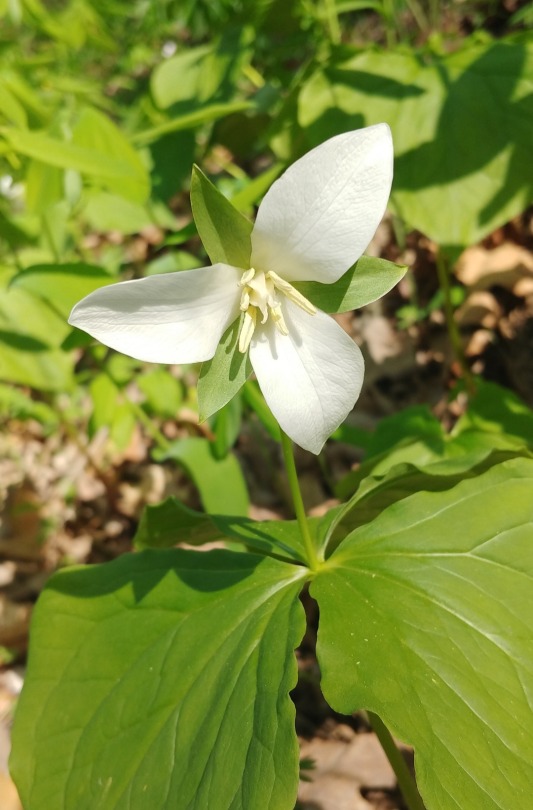
Drooping Trillium
Trillium flexipes
April 12th, 2023
St. Louis County, Missouri, USA
Olivia R. Myers
@oliviarosaline
#botany#Trillium flexipes#trillium#wakerobin#nature#Melanthiaceae#woods#forest#forest floor#spring#spring flowers#The ozarks#ozarks#Missouri#wildflowers#native plants#white flowers#fairycore#naturecore#forestcore#cottagecore#native flowers#flower photography#plant photography#plants#flowers#nodding wakerobin#hiking#nature photography#drooping trillium
46 notes
·
View notes
Photo
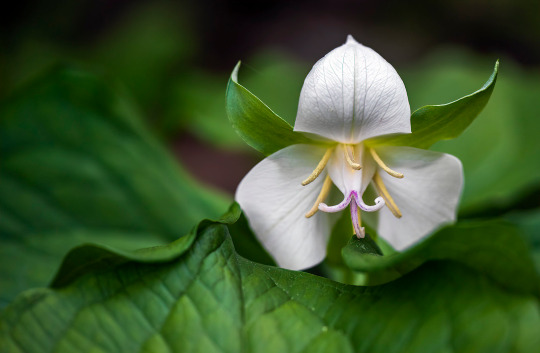
(via Pinterest)
Bernie Kasper / Flickr
Trillium flexipes (Drooping Trillium)
26 notes
·
View notes
Text
Bent Trillium (Trillium flexipes Raf.)
Trilliaceae (Trillium Family)
Synonym(s): Nodding Wakerobin, Nodding Trillium, Bent Trillium, Bent Wakerobin
Base Flower Color: WhiteReproductive Phenology: Apr, May, JunBloom Notes: Creamy anthers, white to pink ovary.Unusual Characteristics: Notice the last plant has 4 petals. stamens and leaves!
For more information about this plant, Click Here.

View On WordPress
0 notes
Photo

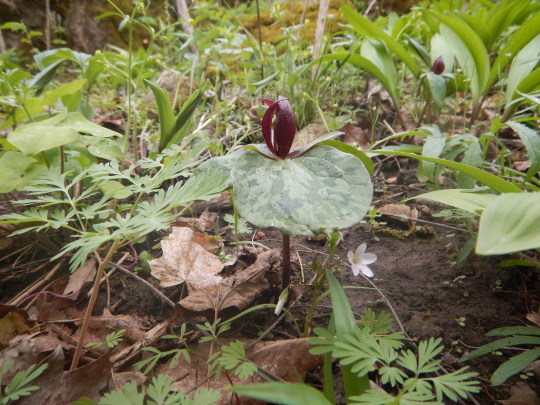



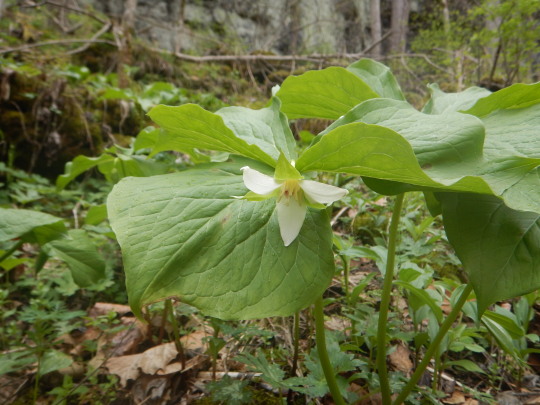
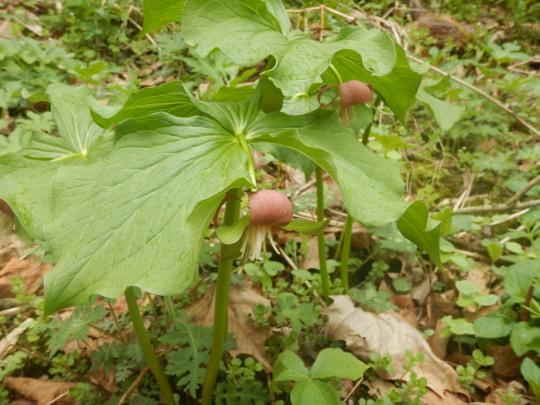


Small variation in Trillium spp.
Leaf modelling is a common species trait among the more common sessile trilliums. Variation in modelling is more common than that of non modelled foliage(most likely do to browsing selection of that trait). Floral color is a bit different, variation in color happens a bit less in Trillium spp. and while it occurs in enough frequency that you will probably stumble into floral variation on any walk through high quality habitat, its much less of an occurrence than variable modelling or height.
Trillium sessile forma luteum is a relatively common form of the normal red Trillium sessile, often misidentified as the much larger giant yellow sessile trillium Trillium luteum.
As for our nodding tall friend here, Trillium flexipes, displays variability from common selective pressure in height rather than modelling. At first glance I actually thought the white one might be the white form of T. erectum due to the red color of the stigma, upon closer look the ovaries were not red though. Trillium flexipes forma roseum.
Trillium grandiflora is also known for a roseum form, however it’s often confused with it’s white fading to pink aging in the corolla.
Trillium flexipes and T. cernuum are a bit difficult to id without flower, stigma is much larger than the staminode filaments on T. flexipes where they are at the same level on T. cernuum. T. erectum is much easier, very erect, has a deep red ovaries', and has a fetid odor.
#botany#plantblr#trillium#plants#wildflowers#trillium flexipes#trillium erectum#trillium grandiflora#trillium cernuum#trillium sessile#ohio#ecology#morphology
85 notes
·
View notes
Photo


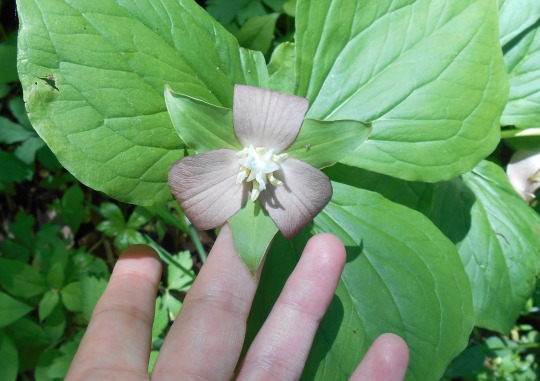
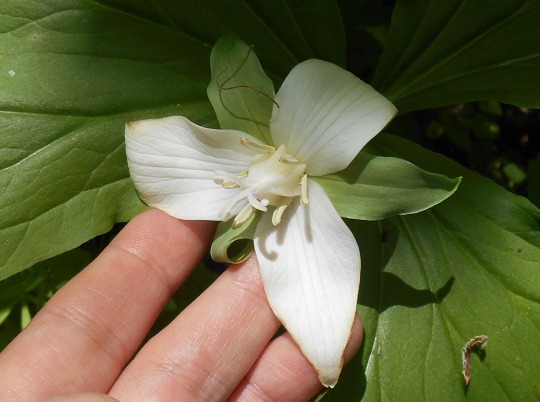
Trillium flexipes: a rare sextillium!!!!!!, three color variations of typical flowers
10 notes
·
View notes
Text
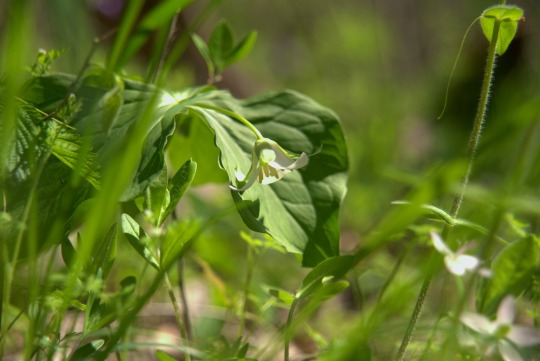
Played around with a fancy camera this past weekend and got this glamor shot of a Trillium flexipes. It's enough to make one weep.
3 notes
·
View notes
Photo

Trillium flexipes
Please check out our website here: http://lakesideendeavors.com/growwild/
#Trillium flexipes#wildflower#wild flower#wild flowers#wildflowers#flower#flowers#plant#plants#nature#nature photography#photography#garden#gardens#gardening#wildflower gardening#growwild#growild
39 notes
·
View notes
Text
Ontario Trilliums ranked by rarity (commonest to rarest)
White Trillium (Trillium grandiflorum)
Red Trillium (Trillium erectum)
Nodding Trillium (Trillium cernuum)
Painted Trillium (Trillium undulatum)
Drooping Trillium (Trillium flexipes) (Endangered, only 2 wild populations left)
Yellow Trillium (Trillium luteum) (1 population. Debate on it being naturalized)
Contrary to what nurseries may brand/sell/tell you, Prairie Trillium (Trillium recurvatum) is not native to Ontario.
4 notes
·
View notes
Photo

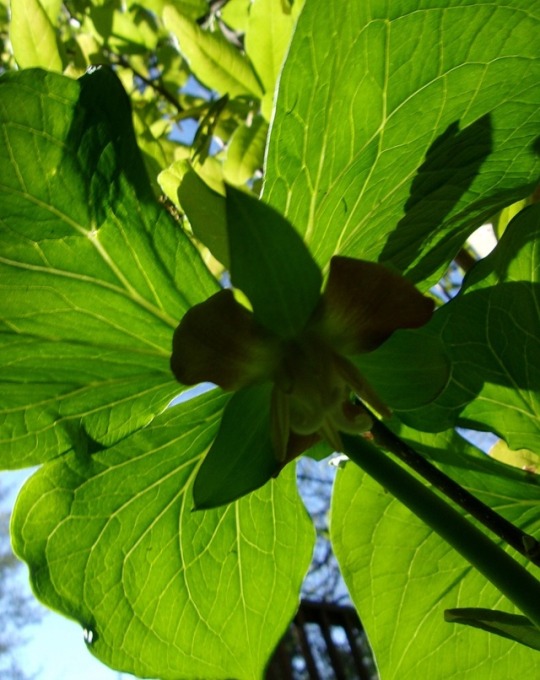

From the garden - some wildflowers.
Drooping trillium (Trillium flexipes), Dwarf larkspur (Delphium tricorn). Backdrop: Butterweed (Senecio glabellus).
5 notes
·
View notes
Text
The Ping-Pong Patch
The Table Tennis Arena
If COVID-19 wasn’t worrisome enough, we dodged tornadoes, scared off black vultures, and survived two nights of hard freezes this month. Gardening and Ping-Pong, peculiar bedfellows, eased my restless mind.
The Ping-Pong table, dubbed a “table tennis arena” by New York Times writer Michael Tortorello, is getting a workout this spring in our Salvisa barn. So is the adjacent patch of shade plants.
Ping-Pong Patch and the crooked corn crib
Mac Reid, a neighbor and life-long friend, and I play Ping-Pong several times a week. We are semi-isolationists. Neither one of us wanders far from home, except for essential shopping, wildflower walks and Ping-Pong. We maintain a social distance of 9’—the length of the table—when we play. I can jaw with the best of them, but only occasionally win a game. (Mac has a bag of trick shots.) We wash our hands after each match.
Trillium flexipes.
The saucer magnolia, adjacent to the arena provided ample cover for shade-loving plants until wood-pecking, yellow-bellied sapsuckers along with bitter cold nearly wiped out the tree four years ago. I had watched sapsuckers poke bands of holes up and down the 45-year-old magnolia for several years beforehand.
I was warned that the naughty sapsuckers could kill the tree. I ignored the experts. And, following a cold winter (-20F/-29C), the magnolia lost its zest. That spring, the top third of the tree, weakened by sapsuckers, was dead. I told Rose we should take it down.
“No, No, No,” she pleaded. Robert Rollins, our go-to arborist and marriage counselor for all things dendroidal, mediated. “Well, it still looks like it’s has a little life.” My strategy hung on Robert’s emphasis of “little life.”
I lost the argument.
The saucer magnolia riddled with sapsucker holes. An old wash sink is parked nearby.
Robert’s crew, with the heart-strings-pulling company name SavATree, cut out the dead wood. That summer, and for the next three years, puny water sprouts grew in weak desperation. The tree, stripped down, looked like Paul Bunyan’s coat rack.
Our stew pot of herbaceous plants fought it out underneath the diminished shade of the saucer magnolia. An old concrete wash sink sits parked close by, waiting for inspiration and muscle to move it somewhere else for a purpose beyond junk. A decoy owl is perched in the branches overhead. The sapsuckers seem confused.
Box elder (Acer negundo) takes flight with a shower of helicopters. And, oh my, the naughty, maple tree seedlings to follow.
The small patch, with its evenly moist, rich soil, continued to accept an ever-increasing number of orphaned shade-loving and resilient odds and ends. Little attention was provided beyond pulling up box elder seedlings and celandine poppies that Bob Hill warns: “… will populate like gerbils.”
Celandine poppy (Stylophorum diphyllum). “Populates like gerbils,” warns Bob Hill.
Some comfort was given last spring when I put in a moss walkway next to the crooked corncrib. This small gesture freshened things up and showered the forsaken patch with a little life and love.
The space, around the arena, was never ignored completely, but it didn’t get the full attention it deserved—until this March when, once again, for ten days, there were gorgeous magnolia blooms in the Ping-Pong Patch
Camassia leichtlinii ‘Blue Danube’
Somehow, miraculously, our dreamy magnolia blooms were not turned into ugly brown tissue paper by the typical, odds-on killing frost.
Redbud and dogwood blooms in the Bluegrass swept in and moved out.
Tree frog in a sassafras
Virginia blue bells, trilliums, primroses and little brown jugs partnered up with a young sassafras and a tree frog.
The little patch rejoiced.
The Ping-Pong Patch originally appeared on GardenRant on April 29, 2020.
The post The Ping-Pong Patch appeared first on GardenRant.
from Gardening https://www.gardenrant.com/2020/04/the-ping-pong-patch.html
via http://www.rssmix.com/
0 notes
Text
Garlic Mustard

Garlic mustard is an invasive herb native to Europe. It was brought to North America in the early 1800s for use as an edible herb. Available in the early spring and high in vitamins A and C, it has a strong, distinctive smell similar to garlic. Since its arrival in North America it has escaped into the wild and is now one of Ontario’s most aggressive forest invaders.
Garlic mustard has two distinct life stages over its first two years. In the first year, it grows only a cluster of leaves shaped like a rosette, while a strong root system develops. Plants that survive the winter produce flowers and hundreds of seeds in their second year. Dense stands produce more than 60,000 seeds per square metre. Stands of garlic mustard can double in size every four years.
Garlic mustard seeds are easily spread by people and animals. They can remain in the soil for up to 30 years and still be able to sprout. The plant can grow in a wide range of sunny and fully shaded habitats, including undisturbed forest, forest edges, riverbanks and roadsides. Garlic mustard does not provide a valuable food source for native wildlife.
Garlic mustard is established in southern and eastern Ontario as far north as Sault Ste. Marie, in parts of Quebec, and south to North Carolina and Kentucky in the United States. Isolated populations have been found in British Columbia, Nova Scotia, Prince Edward Island and New Brunswick.
Its impacts include:
Garlic mustard can invade relatively undisturbed forests. Once established, it can displace native wildflowers like trilliums (Trillium sp) and trout lily (Erythronium americanum). It hinders other plants by interfering with the growth of fungi that bring nutrients to the roots of the plants.
The plant threatens several of Ontario’s species at risk, including American ginseng (Panax quinquefolius), drooping trillium (Trillium flexipes), false rue-anemone (Enemion biternatum), hoary mountain mint (Pycnanthemum incanum), white wood aster (Eurybia divaricata), wild hyacinth (Camassia scilloides) and wood poppy (Stylophorum diphyllum).
0 notes
Photo


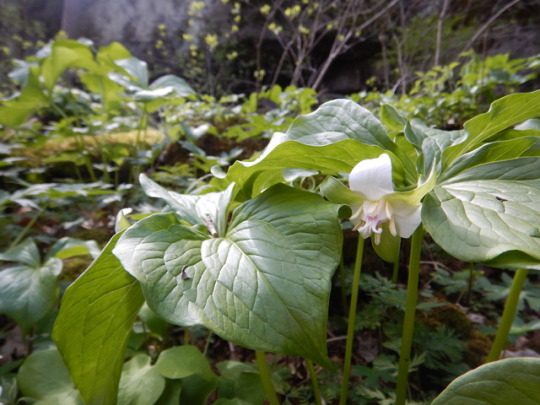

Trillium flexipes,
another common Trillium spp. in the state of Ohio is Trillium flexipes. As far as Trillium species go this one may be the tallest out of our natives. It does have red forms and can be semi erect much like a close look-a-like, Trillium erectum. If you aren’t keen on remembering leaf sizes but have a good sense of smell, it’s ok to take a wif. Trillium flexipes can have little to no odor and tends to be sweet if a smell is present, where T. erectum is rather fetid and promotes fly pollination. If you see a completely red stigmatic base and it smells bad, you should have a good way to tell the two apart.
#trillium flexipes#trillium#wildflowers#ohio#plants#botany#plantblr#nature#nature photography#my photography#photographers on tumblr
7 notes
·
View notes
Photo

Hello May! First white trillium of the year, and they are rare here. @heartthesouth gets all the credit for spotting them on our hike today. The common name is nodding wakerobin.
Trillium flexipes: Trillium from the Latin tri, which refers to the flower parts that occur in threes and llium from the Latin liliaceous, which refers to the funnel-shaped flower, and flexipes – from the Latin flexus – bent, which refers to the flower’s pedicel being bent in the most common morphology. Source: https://www.fs.fed.us/wildflowers/plant-of-the-week/trillium_flexipes.shtml
Personal photo, 5/1/18. Three Benches on Sinks Trail, Monte Sano State Park.
#hiking#nodding wakerobin#trillium flexipes#sinks trail#three benches#Monte Sano State Park#Monte Sano Mountain#sweet home alabama
8 notes
·
View notes
Text
*squints* actually since Trillium erectum, T. flexipes, and T. cernuum are native to Ontario, I wonder if any hybrids of the three exist in the wild in Ontario somewhere? The Trillium erectum group of trillium species tend to get pretty slutty if american Trillium literature has anything to say about it.
#imagine just walking into the woods and getting your eyes smacked by some of the pretty forms that T erectum hybrids can offer#ramblings#plantblr
1 note
·
View note
